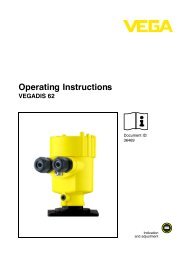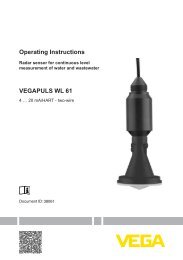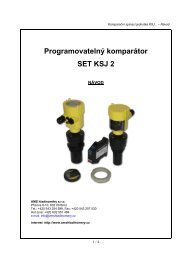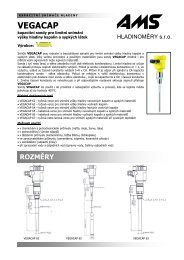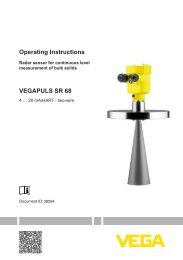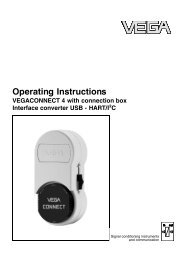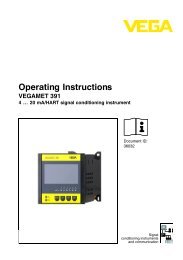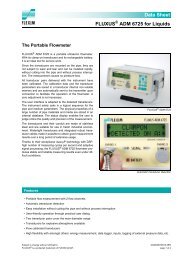Operating Instructions - VEGAVIB 63 with relay output
Operating Instructions - VEGAVIB 63 with relay output
Operating Instructions - VEGAVIB 63 with relay output
Create successful ePaper yourself
Turn your PDF publications into a flip-book with our unique Google optimized e-Paper software.
About this document1 About this document1.1 FunctionThis operating instructions manual has all the information youneed for quick setup and safe operation of <strong>VEGAVIB</strong> <strong>63</strong>.Please read this manual before you start setup.1.2 Target groupThis operating instructions manual is directed to trainedpersonnel. The contents of this manual should be madeavailable to these personnel and put into practice by them.1.3 Symbolism usedInformation, tip, noteThis symbol indicates helpful additional information.Caution, warning, dangerThis symbol informs you of a dangerous situation that couldoccur. Ignoring this cautionary note can impair the person and/or the instrument.Ex applicationsThis symbol indicates special instructions for Ex applications.làListThe dot set in front indicates a list <strong>with</strong> no implied sequence.ActionThis arrow indicates a single action.1 SequenceNumbers set in front indicate successive steps in a procedure.4 <strong>VEGAVIB</strong> <strong>63</strong> - <strong>with</strong> <strong>relay</strong> <strong>output</strong>29277-EN-050812
For your safety2 For your safety2.1 Authorised personnelAll operations described in this operating instructions manualmust be carried out only by trained, specialised personnelauthorised by the operator. For safety and warranty reasons,any internal work on the instruments must be carried out onlyby personnel authorised by the manufacturer.2.2 Appropriate use<strong>VEGAVIB</strong> <strong>63</strong> is a sensor for level detection.Detailed information on the application range of <strong>VEGAVIB</strong> <strong>63</strong>is available in chapter Product description.2.3 Warning about misuseInappropriate or incorrect use of the instrument can give rise toapplication-specific hazards, e.g. vessel overfill or damage tosystem components through incorrect mounting or adjustment.2.4 General safety instructions<strong>VEGAVIB</strong> <strong>63</strong> is a high-tech instrument requiring the strictobservance of standard regulations and guidelines. The usermust take note of the safety instructions in this operatinginstructions manual, the country-specific installation standards(e.g. the VDE regulations in Germany) as well as all prevailingsafety regulations and accident prevention rules.2.5 CE conformity<strong>VEGAVIB</strong> <strong>63</strong> is in CE conformity <strong>with</strong> EMC (89/336/EWG),fulfils the NAMUR recommendation NE 21 and is in CEconformity <strong>with</strong> LVD (73/23/EWG).Conformity has been judged acc. to the following standards:29277-EN-050812lEMC:- Emission EN 61326: 1997 (class B)- Susceptibility EN 61326: 1997/A1: 1998l LVD: EN 61010-1: 2001<strong>VEGAVIB</strong> <strong>63</strong> - <strong>with</strong> <strong>relay</strong> <strong>output</strong> 5
Product description3 Product description3.1 ConfigurationScope of deliveryComponentsThe scope of delivery encompasses:ll<strong>VEGAVIB</strong> <strong>63</strong> level sensorDocumentation- this operating instructions manual- Ex-specific safety instructions (<strong>with</strong> Ex versions) and, ifnecessary, further certificates<strong>VEGAVIB</strong> <strong>63</strong> consists of the following components:lllHousing coverHousing <strong>with</strong> electronicsprocess fitting <strong>with</strong> vibrating rod123Fig. 1: <strong>VEGAVIB</strong> <strong>63</strong> - <strong>with</strong> plastic housing1 Housing cover2 Housing <strong>with</strong> electronics3 Process fitting3.2 Principle of operation29277-EN-050812Area of application<strong>VEGAVIB</strong> <strong>63</strong> is a level sensor <strong>with</strong> vibrating rod for leveldetection.It is designed for industrial use in all areas of processtechnology and is preferably used for bulk solids.<strong>VEGAVIB</strong> <strong>63</strong> - <strong>with</strong> <strong>relay</strong> <strong>output</strong> 7
Product descriptionTypical applications are overfill and dry run protection. Thanksto its simple and robust measuring system, <strong>VEGAVIB</strong> <strong>63</strong> isvirtually unaffected by the chemical and physical properties ofthe solid.It functions even when exposed to strong external vibration orchanging products.Solid detection in waterIf <strong>VEGAVIB</strong> <strong>63</strong> was ordered for solid detection in water, thevibrating rod is to the density of water. In air or if covered bywater (density: 1 g/cm³/0.036 lbs/in) <strong>VEGAVIB</strong> <strong>63</strong> signalsuncovered. Only if the vibrating element is also covered <strong>with</strong>solids (e.g. sand, sludge, gravel etc.) will the sensor signalcovered.Fault monitoringThe electronics of <strong>VEGAVIB</strong> <strong>63</strong> continuously monitors thefollowing criteria:l Correct vibrating frequencyl Line break to the piezo driveIf one of these faults is detected or in case the power supplyfails, the electronics takes on a defined switching condition, i.e.the <strong>relay</strong> deenergizes (safe condition).Physical principlePower supplyThe vibrating rod is piezoelectrically energised and vibrates atits mechanical resonance frequency of approx. 360 Hz. Whenthe vibrating rod is submerged in the product, the vibratingamplitude changes. This change is detected by the integratedoscillator and converted into a switching command.<strong>VEGAVIB</strong> <strong>63</strong> is a compact instrument, i.e. it can be operated<strong>with</strong>out external evaluation system. The integrated electronicsevaluates the level signal and <strong>output</strong>s a switching signal. Withthis switching signal, a connected device can be operateddirectly (e.g. a warning system, a PLC, a pump etc.).The exact range of the power supply is stated in the Technicaldata in the Supplement.3.3 AdjustmentWith the factory setting <strong>with</strong> a density >0.05 g/cm³ (>0.002 lbs/in³) can be measured. The instrument can be adapted ifproducts <strong>with</strong> lower density should be measured.On the electronics module you will find the following indicatingand adjustment elements:8 <strong>VEGAVIB</strong> <strong>63</strong> - <strong>with</strong> <strong>relay</strong> <strong>output</strong>29277-EN-050812
Product descriptionlllsignal lamp for indication of the switching condition (green/red)potentiometer for adaptation to the product densitymode switch for selection of the <strong>output</strong> current3.4 Storage and transportPackagingStorage and transport temperatureYour instrument was protected by packaging during transport.Its capacity to handle normal loads during transport is assuredby a test acc. to DIN 55439.The packaging of standard instruments consists of environment-friendly,recyclable cardboard. In addition, the sensor isprovided <strong>with</strong> a protective cover of cardboard. For specialversions PE foam or PE foil is also used. Dispose of thepackaging material via specialised recycling companies.l Storage and transport temperature see "Supplement -Technical data - Ambient conditions"l Relative humidity 20 … 85 %29277-EN-050812<strong>VEGAVIB</strong> <strong>63</strong> - <strong>with</strong> <strong>relay</strong> <strong>output</strong> 9
Mounting4 Mounting4.1 General instructionsSwitching pointMoistureIn general, <strong>VEGAVIB</strong> <strong>63</strong> can be mounted in any position. Theinstrument must be mounted in such a way that the tuning forkis at the height of the requested switching point.Use the recommended cable (see chapter "Connecting topower supply") and tighten the cable entry.You can give your <strong>VEGAVIB</strong> <strong>63</strong> additional protection againstmoisture penetration by leading the connection cable downwardin front of the cable entry. Rain and condensation watercan thus drain off. This applies mainly to mounting outdoors, inareas where moisture is expected (e.g. by cleaning processes)or on cooled or heated vessels.Fig. 2: Measures against moisture penetrationTransportPressure/VacuumDo not hold <strong>VEGAVIB</strong> <strong>63</strong> on the vibrating element. Especially<strong>with</strong> flange and tube versions, the sensor can be damaged bythe weight of the instrument.Remove the protective cover just before mounting.The process fitting must be sealed if there is gauge or lowpressure in the vessel. Before use, check if the seal material isresistant against the measured product and the processtemperature.HandlingThe vibrating level switch is a measuring instrument and mustbe treated accordingly. Bending the vibrating element willdestroy the instrument.10 <strong>VEGAVIB</strong> <strong>63</strong> - <strong>with</strong> <strong>relay</strong> <strong>output</strong>29277-EN-050812
MountingWarning:The housing must not be used to screw the instrument in!Applying tightening force to the housing can damage itsinternal mechanical components.To screw in, use the hexagon above the thread.4.2 Mounting informationAgitators and fluidizationDue to agitators, vibrations or similar, the level switch can besubjected to strong lateral forces. For this reason, do not usean overly long extension tube for <strong>VEGAVIB</strong> <strong>63</strong>, but check if youcan mount a short level switch on the side of the vessel inhorizontal position.Extreme vibrations from the system side, e.g. by agitators orturbulence in the vessel, e.g. by fluidization can cause theextension tube of <strong>VEGAVIB</strong> <strong>63</strong> to vibrate. This will causeincreased stress on the upper weld joint. Should a longer tubeversion be necessary, you can provide a suitable straining orfastening directly above the tuning fork to fasten the extensiontube.This measure applies particularly to applications in Ex areas.Make sure that the tube is not subjected to bending forcesthrough this measure.Inflowing materialIf <strong>VEGAVIB</strong> <strong>63</strong> is mounted in the filling stream, unwantedswitching signals may be generated. Mount <strong>VEGAVIB</strong> <strong>63</strong> at alocation in the vessel where no disturbing influence from e.g.filling openings, agitators, etc. can occur.This applies particularly to instrument types <strong>with</strong> longextension tube.29277-EN-050812<strong>VEGAVIB</strong> <strong>63</strong> - <strong>with</strong> <strong>relay</strong> <strong>output</strong> 11
MountingFig. 3: Inflowing materialLock fittingSocketMaterial cone<strong>VEGAVIB</strong> <strong>63</strong> can be mounted <strong>with</strong> a lock fitting for heightadjustment. Take note of the pressure information of the lockfitting.The vibrating element should protrude into the vessel to avoidbuildup. For that reason, avoid using mounting bosses forflanges and screwed fittings. This applies particularly to use<strong>with</strong> adhesive products.Material cones can form in solids silos which can change theswitching point. Please keep this in mind when installing thesensor in the vessel. We recommend selecting an installationlocation where the vibrating rod detects an average value ofthe material cone.Depending on the arrangement of the filling and emptyingopening in the vessel, the vibrating rod must be mountedrespectively.To compensate measurement errors in cylindrical vesselscaused by the material cone, the sensor must be mounted at adistance of d/6 from the vessel wall.12 <strong>VEGAVIB</strong> <strong>63</strong> - <strong>with</strong> <strong>relay</strong> <strong>output</strong>29277-EN-050812
Mountingd6d6ddFig. 4: Filling and emptying centered29277-EN-050812<strong>VEGAVIB</strong> <strong>63</strong> - <strong>with</strong> <strong>relay</strong> <strong>output</strong> 13
d6dMounting123Fig. 5: Filling in the center, emptying laterally1 <strong>VEGAVIB</strong> <strong>63</strong>2 Emptying opening3 Filling openingBaffle for protection againstphysical damageIn applications such as grit chambers or settling basins forcoarse sediments, the vibrating element must be protectedagainst damage <strong>with</strong> a suitable baffle.14 <strong>VEGAVIB</strong> <strong>63</strong> - <strong>with</strong> <strong>relay</strong> <strong>output</strong>29277-EN-050812
Mounting>150Fig. 6: Baffle for protection against physical damage29277-EN-050812<strong>VEGAVIB</strong> <strong>63</strong> - <strong>with</strong> <strong>relay</strong> <strong>output</strong> 15
Connecting to power supply5 Connecting to power supply5.1 Preparing the connectionNote safety instructionsTake note of safetyinstructions for ExapplicationsSelect power supplySelecting the connection cableAlways observe the following safety instructions:lConnect only in the complete absence of line voltageIn hazardous areas you should take note of the appropriateregulations, conformity and type approval certificates of thesensors and power supply units.Connect the power supply acc. to the following diagrams.Oscillator VB 60R is designed in protection class 1. Tomaintain this protection class, it is absolutely necessary thatthe ground conductor is connected to the internal groundterminal. Take note of the general installation regulations. As arule, connect <strong>VEGAVIB</strong> <strong>63</strong> to vessel ground (PA), or in case ofplastic vessels, to the next ground potential. On the side of thehousing there is a ground terminal between the cable entries.This connection serves to drain off electrostatic charges. In Exapplications, the installation regulations for hazardous areasmust be given priority.The data for power supply are stated in the Technical data inthe Supplement.<strong>VEGAVIB</strong> <strong>63</strong> is connected <strong>with</strong> standard cable <strong>with</strong> round wirecross section. An outer cable diameter of 5 … 9 mm(0.2 … 0.35 in) ensures the seal effect of the cable entry.If cable <strong>with</strong> a different diameter or wire cross section is used,exchange the seal or use an appropriate cable connection.In hazardous areas, only use approved cable connections for<strong>VEGAVIB</strong> <strong>63</strong>.Select connectioncable for Ex applicationsTake note of the corresponding installation regulations for Exapplications.5.2 Connection procedureWith Ex instruments, the housing cover may only be opened ifthere is no explosive atmosphere.Proceed as follows:16 <strong>VEGAVIB</strong> <strong>63</strong> - <strong>with</strong> <strong>relay</strong> <strong>output</strong>29277-EN-050812
Connecting to power supply1 Unscrew the housing cover2 Loosen compression nut of the cable entry3 Remove approx. 10 cm (4 in) of the cable mantle, stripapprox. 1 cm (0.4 in) insulation from the ends of theindividual wires4 Insert the cable into the sensor through the cable entry5 Lift the opening levers of the terminals <strong>with</strong> a screwdriver(see following illustration)6 Insert the wire ends into the open terminals according tothe wiring plan7 Press down the opening levers of the terminals, you willhear the terminal spring closing8 Check the hold of the wires in the terminals by lightlypulling on them9 Tighten the compression nut of the cable entry, the sealring must completely encircle the cable10 Screw the housing cover back onThe electrical connection is finished.Fig. 7: Connection steps 5 and 629277-EN-050812<strong>VEGAVIB</strong> <strong>63</strong> - <strong>with</strong> <strong>relay</strong> <strong>output</strong> 17
Connecting to power supply5.3 Wiring plans, single chamber housingThe following illustrations apply to the non-Ex as well as to theEEx d version.Housing overview44412 3Fig. 8: Material versions, single chamber housing1 Plastic (not <strong>with</strong> EEx d)2 Aluminium3 Stainless steel (not <strong>with</strong> EEx d)4 Filter element for pressure compensation (not <strong>with</strong> EEx d)Electronics and connectioncompartment15243Wiring planFig. 9: Electronics and connection compartment1 Potentiometer for switching point adaptation (covered)2 DIL switch for mode adjustment3 Ground terminal4 Terminals5 Control lampWe recommend connecting <strong>VEGAVIB</strong> <strong>63</strong> in such a way thatthe switching circuit is open when there is a level signal, linebreak or failure (safe condition).18 <strong>VEGAVIB</strong> <strong>63</strong> - <strong>with</strong> <strong>relay</strong> <strong>output</strong>29277-EN-050812
Connecting to power supplyThe <strong>relay</strong>s are always shown in non-operative condition.32 1Fig. 10: Wiring plan1 Relay <strong>output</strong>2 Relay <strong>output</strong>3 Supply voltage29277-EN-050812<strong>VEGAVIB</strong> <strong>63</strong> - <strong>with</strong> <strong>relay</strong> <strong>output</strong> 19
Set up6 Set up6.1 GeneralThe numbers in brackets refer to the following illustrations.Function/ConfigurationOn the electronics module you will find the following indicatingand adjustment elements:l Potentiometer for switching point adaptation (1)l DIL switch for mode adjustment - min/max (2)l Signal lamp (5)Note:As a rule, always set the mode <strong>with</strong> the mode switch (2) beforestarting to set up <strong>VEGAVIB</strong> <strong>63</strong>. The switching <strong>output</strong> willchange if you set the mode switch (2) afterwards. This couldpossibly trigger other connected instruments or devices.6.2 Adjustment elements51243Fig. 11: Electronics module VB 60R - Relay <strong>output</strong>1 Potentiometer for switching point adaptation2 DIL switch for mode adjustment3 Ground terminal4 Terminals5 Control lamp20 <strong>VEGAVIB</strong> <strong>63</strong> - <strong>with</strong> <strong>relay</strong> <strong>output</strong>29277-EN-050812
Set upSwitching point adaptation (1)Mode adjustment (2)Signal lamp (5)You can adapt the switching point to the solid <strong>with</strong> thepotentiometer. The switching point is preset and covered by alabel. It must only be modified in special cases.By default, the potentiometer of <strong>VEGAVIB</strong> <strong>63</strong> is set to midposition (0.05 … 1 g/cm³ or 0.002 … 0.036 lbs/in³). In very lightsolids, turn the potentiometer to complete left position(0.02 … 0.1 g/cm³ or 0.0007 … 0.0036 lbs/in³). By doing this,<strong>VEGAVIB</strong> <strong>63</strong> will be more sensitive and light solids can bedetected more reliably.For very heavy solids, turn the potentiometer to the completeright position (>0.3 g/cm³ or >0.011 lbs/in³). Hence <strong>VEGAVIB</strong><strong>63</strong> is less sensitive.For instruments detecting solids in water, these values are notapplicable. The potentiometer is preset and must not bechanged.With the mode adjustment (min./max.) you can change theswitching condition of the <strong>relay</strong>. You can set the required modeacc. to the "Function chart" (max. -max. detection or overfillprotection, min. -min. detection or dry run protection).We recommend connecting acc. to the quiescent currentprinciple (replay contact deenergizes when reaching theswitching point), because the <strong>relay</strong> takes on the same (safe)condition if a failure is detected.Signal lamp for indication of the switching condition.lllgreen = <strong>relay</strong> energizedred = <strong>relay</strong> deenergizedred (flashing) = failure6.3 Function chartThe following chart provides an overview of the switchingconditions depending on the adjusted mode and level.max. modeOverfill protectionLevelSwitching statusControl lamp29277-EN-0508123 4 5(6) (7) (8)Relay energized green<strong>VEGAVIB</strong> <strong>63</strong> - <strong>with</strong> <strong>relay</strong> <strong>output</strong> 21
Set upmax. modeOverfill protectionLevelSwitching statusControl lamp3 4(6) (7)5(8)min. modeDry run protectionRelay deenergizedred3 4(6) (7)5(8)min. modeDry run protectionRelay energizedgreen3 4(6) (7)5(8)Relay deenergizedredFailure of thesupply voltage(min./max. mode)any3 4(6) (7)5(8)Relay deenergizedFailureany3 4(6) (7)5(8)Relay deenergizedflashes red22 <strong>VEGAVIB</strong> <strong>63</strong> - <strong>with</strong> <strong>relay</strong> <strong>output</strong>29277-EN-050812
Maintenance and fault rectification7 Maintenance and fault rectification7.1 MaintenanceWhen used as directed in normal operation, <strong>VEGAVIB</strong> <strong>63</strong> iscompletely maintenance-free.7.2 Fault rectificationChecking the switching signalCauses of malfunctionFault rectification<strong>VEGAVIB</strong> <strong>63</strong> offers maximum reliability. Nevertheless faultscan occur during operation. These may be caused by thefollowing, e.g.:l Sensorl Processl Power supplyl Signal processing.The first measure is checking the <strong>output</strong> signal. In many casesthe reasons can be determined and faults rectified.29277-EN-05081224 hour service hotlineShould the following measures not be successful, please callin urgent cases the VEGA service hotline under the phonenumber +49 1805 858550.The hotline is available to you 7 days a week round-the-clock.Since we offer this service world-wide, the support is onlyavailable in the English language. The service is free ofcharge, only the standard telephone costs will be charged.? <strong>VEGAVIB</strong> <strong>63</strong> signals "covered" when the vibrating elementis not submerged (overfill protection)? <strong>VEGAVIB</strong> <strong>63</strong> signals "uncovered" when the vibratingelement is submerged (dry run protection)l Supply voltage too lowà Check the power supplyl Electronics defectiveà Push the mode switch (min./max.). If the instrumentthen changes the mode, the instrument may bemechanically damaged. Should the switching functionin the correct mode still be faulty, return the instrumentfor repair.<strong>VEGAVIB</strong> <strong>63</strong> - <strong>with</strong> <strong>relay</strong> <strong>output</strong> 23
Maintenance and fault rectificationà Push the mode switch. If the instrument then does notchange the mode, the oscillator may be defective.Exchange the oscillator.à Check if there is buildup on the vibrating element, and ifso, remove it.l Unfavourable installation locationà Mount the instrument at a location where no deadzones or mounds can form in the vessel.à Check if the vibrating element is covered by buildup onthe socket.l Wrong mode selectedà Set the correct mode on the mode switch (max: overfillprotection; min: dry run protection). Wiring should becarried out acc. to the quiescent current principle.? Signal lamp flashes redl Electronics has detected a failureà Exchange instrument or return it for repair7.3 Exchanging the electronicsIn general, all oscillators of series VB60 can be interchanged. Ifyou want to use an oscillator <strong>with</strong> a different signal <strong>output</strong>, youcan download the corresponding operating instructions manualfrom our homepage under Downloads.With EExd instruments, the housing cover must only beopened if there is no explosive atmosphere.Proceed as follows:1 Switch off power supply2 Unscrew the housing cover3 Lift the opening levers of the terminals <strong>with</strong> a screwdriver4 Pull the connection cables out of the terminals5 Loosen the two screws <strong>with</strong> a Phillips screwdriver (size 1)24 <strong>VEGAVIB</strong> <strong>63</strong> - <strong>with</strong> <strong>relay</strong> <strong>output</strong>29277-EN-050812
Maintenance and fault rectification12Fig. 12: Loosen the screws1 Electronics module2 Screws (2 pcs.)6 Remove the old oscillator7 Compare the new oscillator <strong>with</strong> the old one. The type labelof the oscillator must correspond to that of the oldoscillator. This applies particularly to instruments used inhazardous areas.8 Compare the settings of the two oscillators. Set theadjustment elements of the new oscillator to the settings ofthe old oscillator.Information:Make sure that the housing is not rotated during the electronicsexchange. Otherwise the plug may be in a different positionlater.29277-EN-0508129 Insert the oscillator carefully. Make sure that the plug is inthe correct position.10 Screw in and tighten the two screws <strong>with</strong> a Phillipsscrewdriver.11 Insert the wire ends into the open terminals according tothe wiring plan12 Close the opening levers of the terminals, you will hear theterminal spring closing13 Check the hold of the wires in the terminals by lightlypulling on them14 Check the tightness of the cable entry. The seal ring mustcompletely encircle the cable.15 Screw the housing cover back on<strong>VEGAVIB</strong> <strong>63</strong> - <strong>with</strong> <strong>relay</strong> <strong>output</strong> 25
Maintenance and fault rectificationThe electronics exchange is finished.7.4 Instrument repairIf it is necessary to repair <strong>VEGAVIB</strong> <strong>63</strong> please proceed asfollows:You can download a return form (23 KB) from our homepagewww.vega.com under: "Services – Downloads – Forms andCertificates – Repair form".By doing this you help us carry out the repair quickly and<strong>with</strong>out having to call back for needed information.llllPrint and fill out one form per instrumentClean the instrument and pack it damage-proofAttach the completed form and possibly also a safety datasheet to the instrument.Send the instrument to the respective address of youragency. In Germany to the VEGA headquarters inSchiltach.26 <strong>VEGAVIB</strong> <strong>63</strong> - <strong>with</strong> <strong>relay</strong> <strong>output</strong>29277-EN-050812
Dismounting8 Dismounting8.1 Dismounting procedureWarning:Before dismounting, be aware of dangerous process conditionssuch as e.g. pressure in the vessel, high temperatures,corrosive or toxic products etc.Take note of chapters "Mounting" and "Connecting to powersupply" and carry out the listed steps in reverse order.With Ex instruments, the housing cover may only be opened ifthere is no explosive atmosphere.8.2 Disposal<strong>VEGAVIB</strong> <strong>63</strong> consists of materials which can be recycled byspecialised recycling companies. We have purposely designedthe electronic modules to be easily separable. Mark theinstrument as scrap and dispose of it according to nationalgovernment regulations (e.g. in Germany acc. to electronicscrap ordinance).Materials: see "Technical data"If you cannot dispose of the instrument properly, pleasecontact us about disposal methods or return.29277-EN-050812<strong>VEGAVIB</strong> <strong>63</strong> - <strong>with</strong> <strong>relay</strong> <strong>output</strong> 27
Functional safety9 Functional safety9.1 GeneralValidityArea of applicationSafety functionRelevant standardsSafety requirementsThis safety manual applies to measuring systems consisting of<strong>VEGAVIB</strong> <strong>63</strong> vibrating level switches and integrated oscillatorVB60R. The instrument corresponds to a subsystem of type B.The sensor software must correspond at least to version 1.03or higher.The measuring system can be used for level detection ofpowders and granules which meet the specific requirements ofthe safety technology, e.g.:l Mode "max" for overfill protectionl Mode "min" for dry run protectionThe measuring system is qualified in both modes to meet thefollowing requirement degree acc. to IEC 61508-2:l SIL2 <strong>with</strong> architecture 1oo1D (single channel)l SIL3 <strong>with</strong> architecture 1oo2D (double-channel/redundant)With a special factory setting, the measuring system is alsosuitable for detection of solids in water (see operatinginstructions manual).The safety function of this measuring system is the detectionand signalling of the condition of the vibration element. Thesafe condition depends on the mode:llIn mode "max": condition "covered"In mode "min": condition "uncovered"l IEC 61508-1, -2, -4- Functional safety of electrical/electronic/programmableelectronic systemsThe failure limit values for a safety function, depending on theSIL class (of IEC 61508-1, 7.6.2)Safety integrity level Low demand mode High demand modeSIL PFD avg PFH4 >=10 -5 up to =10 -9 up to =10 -4 up to =10 -8 up to =10 -3 up to =10 -7 up to =10 -2 up to =10 -6 up to
Functional safetySafety integrity of the hardware for safety-relating subsystemsof type B (IEC 61508-2, 7.4.3)Safe failure fractionHardwarefault toleranceSFF HFT = 0 HFT = 1 HFT = 2
Functional safetyLow demand modeHigh demand model The communication via the IIC bus interface is only usedfor default scaling and for service purposes.l The repair time (exchange of the meas. system) after a failsafeerror is eight hours (MTTR = 8 h)l In the mode <strong>with</strong> the lowest demand rate, the reaction timeof a connected control and processing unit to dangerousdetectable errors is max. 1 hour.If the demand rate is only once a year, then the measuringsystem can be used as safety-relevant subsystem in "lowdemand mode" (IEC 61508-4, 3.5.12).If the ratio of the internal diagnostics test rate of the measuringsystem to the demand rate exceeds the value 100, themeasuring system can be treated in the way it is executing asafety function in the mode <strong>with</strong> low demand rate (IEC 61508-2,7.4.3.2.5).Corresponding characteristics is the value PFD avg (averageProbability of dangerous Failure on Demand). It is dependenton the test interval T Proof between the function tests of theprotective function.Numbers see paragraph "Safety-technical characteristics".If the "low demand mode" does not apply, the measuringsystem must be used as safety-relevant subsystem in "highdemand" (IEC 61508-4, 3.5.12).The fault tolerance time of the complete system must be higherthan the sum of the reaction times or the diagnostics testperiods of all components in the safety chain.Corresponding characteristics is the value PFH (failure rate).Numbers see paragraph "Safety-technical characteristics".Safe condition and fault descriptionThe safe condition of the measuring system is the switched offstatus (quiescent current principle):l VB60R (<strong>relay</strong> <strong>output</strong>) –Relay deenergizedA fail-safe failure (safe failure) exists if the measuring systemchanges to the defined safe condition <strong>with</strong>out demand of theprocess.If the internal diagnosis system recognises a failure, the safecondition is taken up.A dangerous undetected failure exists if the measuring systemdoes not go to the defined safe condition when required by theprocess.30 <strong>VEGAVIB</strong> <strong>63</strong> - <strong>with</strong> <strong>relay</strong> <strong>output</strong>29277-EN-050812
Functional safetyConfiguration of the processingunitThe processing unit must evaluate the <strong>output</strong> circuit of themeasuring system by taking the quiescent current principleinto account.The processing unit must correspond to the SIL level of themeasuring chain.9.3 SetupMounting and installationThe prevailing plant conditions influence the safety of themeasuring system. Therefore note the mounting and installationinstructions of the appropriate operating instructionsmanual. Mainly important is the correct setting of the mode(min./max.).In heavy or very light-weight solids the switching point of themeasuring system must be adapted acc. to the operatinginstructions manual depending on the density limits.9.4 Reaction during operation and in case offailurellllllThe adjustment elements must not be modified duringoperation.In case of modifications during operation, you have to takenote of the safety functions.Occurring fault signals are described in the appropriateoperating instructions manual.In case of detected failures or fault signals, the entiremeasuring system must be switched out of service and theprocess held in a safe condition by means of othermeasures.An electronics exchange is easily possible and describedin the operating instructions manual.If due to the detected failure, the electronics or thecomplete sensor is interchanged, the manufacturer mustbe informed (incl. a fault description).29277-EN-0508129.5 Recurring function testThe recurring function test serves to reveal potential dangerouserrors that are otherwise not discernible. The function ofthe measuring system must be checked at adequate intervals.The operator is responsible for choosing the type of test andthe intervals in the stated time frame. The time frame dependson the PFD avg value acc. to the chart and diagram in section"Safety-related characteristics".<strong>VEGAVIB</strong> <strong>63</strong> - <strong>with</strong> <strong>relay</strong> <strong>output</strong> 31
Functional safetyIn high demand rate, no recurring function test is arranged inIEC 61508. A proof of the functional efficiency is seen in themore frequent demand of the measuring system. In doublechannel architectures it is useful to proof the redundancy byrecurring function tests in appropriate intervals.The test must be carried out in a way that verifies the flawlessoperation of the safety functions in conjunction <strong>with</strong> all systemcomponents.This is ensured by a controlled reaching of the response heightduring filling. If filling up to the response height is not possible,then a response of the measuring system must be triggered bya suitable simulation of the level or the physical effect.The methods and procedures used during the tests must bestated and their suitability must be specified. The tests must bedocumented.If the function test proves negative, the entire measuringsystem must be switched out of service and the process heldin a safe condition by means of other measures.In the double channel architecture 1oo2D this appliesseparately to both channels.9.6 Safety-related characteristicsThe failure rates of the electronics and the vibrating system aredetermined by an FMEDA acc. to IEC 61508. Thesecalculations are based on component failure rates acc. toSN 29500. All numerical values refer to an average ambienttemperature during the operating time of +40°C (104°F). Thecalculations are also based on the specifications stated inchapter "Planning".Overfill protectionMode switch is set to "max"λ sd 0 FIT safe detected failure (1 FIT = failure/10 9 h)λ su 586 FIT safe undetected failureλ dd 124 FIT dangerous detected failureλ du 27 FIT dangerous undetected failureSFF >96 % Safe Failure FractionDC S 0 % Diagnosis coverage DC S = λ sd /(λ sd + λ su )DC D 82 % Diagnosis coverage DC D = λ dd /(λ dd + λ du )32 <strong>VEGAVIB</strong> <strong>63</strong> - <strong>with</strong> <strong>relay</strong> <strong>output</strong>29277-EN-050812
Functional safetyDry run protectionMode switch is set to "min"λ sd 0 FIT safe detected failureλ su 565 FIT safe undetected failureλ dd 135 FIT dangerous detected failureλ du 37 FIT dangerous undetected failureSFF >95 % Safe Failure FractionDC S 0 % Diagnosis coverage DC S = λ sd /(λ sd + λ su )DC D 78 % Diagnosis coverage DC D = λ dd /(λ dd + λ du )General dataT Diagnosis Diagnosis test periodMTBF = MTTF + MTTRmax. useful life of the measuring system for the safetyfunction100 sec1.33x10 6 happrox. 10 yearsSingle channel architectureArchitecture 1oo1D – OverfillprotectionSIL2 (Safety Integrity Level)HFT = 0 (Hardware Fault Tolerance)Mode switch is set to "max"PFD avgT Proof = 1 yearT Proof = 5 yearsT Proof = 10 years< 0.012 x 10 -2< 0.059 x 10 -2< 0.118 x 10 -2PFH [1/h] < 2.7 x 10 -8 /hArchitecture 1oo1D – Dry runprotectionSIL2 (Safety Integrity Level)HFT = 0 (Hardware Fault Tolerance)Mode switch is set to "min"29277-EN-050812PFD avgT Proof = 1 yearT Proof = 5 yearsT Proof = 10 years< 0.016 x 10 -2< 0.082 x 10 -2< 0.164 x 10 -2PFH [1/h] < 3.7 x 10 -8 /h<strong>VEGAVIB</strong> <strong>63</strong> - <strong>with</strong> <strong>relay</strong> <strong>output</strong> 33
Functional safetyDouble channel architectureHere you see an example how the measuring system in doublechannel architecture can be used in an application <strong>with</strong>demand rate SIL3. ACommon Cause Factor of beta = 10 %(worst case) is taken into account.If the instruments are used in another (multiple channel)architecture, the values must be calculated for the selectedapplication by means of the above failure rates.Architecture 1oo2D – OverfillprotectionSIL3 (Safety Integrity Level)HFT = 1 (Hardware Fault Tolerance)Mode switch is set to "max"PFD avgT Proof = 1 yearT Proof = 5 yearsT Proof = 10 years< 0.012 x 10 -3< 0.059 x 10 -3< 0.120 x 10 -3PFH [1/h] < 1.5 x 10 -8 /hArchitecture 1oo2D – Dry runprotectionSIL3 (Safety Integrity Level)HFT = 1 (Hardware Fault Tolerance)Mode switch is set to "min"PFD avgT Proof = 1 yearT Proof = 5 yearsT Proof = 10 years< 0.016 x 10 -3< 0.081 x 10 -3< 0.160 x 10 -3PFH [1/h] < 1.7 x 10 -8 /hTime-dependent process ofPFD avgThe time-dependent process of PFD avg reacts in the timeperiod up to 10 years virtually linear to the operating time. Theabove values only apply to the T Proof interval, after which arecurring function test must be carried out.34 <strong>VEGAVIB</strong> <strong>63</strong> - <strong>with</strong> <strong>relay</strong> <strong>output</strong>29277-EN-050812
Functional safety4PFD avg3211 5 10 T ProofFig. 13: Time-dependent process of PFD avg1)1 PFD avg = 02 PFD avg after 1 year3 PFD avg after 5 years4 PFD avg after 10 years29277-EN-0508121)Numbers see in the above charts.<strong>VEGAVIB</strong> <strong>63</strong> - <strong>with</strong> <strong>relay</strong> <strong>output</strong> 35
Supplement10 Supplement10.1 Technical dataGeneral dataMaterial 316L corresponds to 1.4404 or 1.4435Materials, wetted parts- Process fitting – Thread 316L- Process fitting - Flange 316L- Process seal Klingersil C-4400- Vibrating rod 316L/1.4462 (318S13)- Extension tube ø 29 mm (ø 1.14 in) 316LMaterials, non-wetted parts- Housing plastic PBT (Polyester), Alu-die casting powder-coated,stainless steel 316L- Seal ring between housing andhousing cover- Ground terminal 316LNBR (stainless steel housing), silicone (Alu/plastic housing)Weights- <strong>with</strong> plastic housing 1150 g (40 oz)- <strong>with</strong> Aluminium housing 1600 g (56 oz)- <strong>with</strong> stainless steel housing 1950 g (69 oz)- Extension tube approx. 1450 g/m (15.6 oz/ft)Sensor length0.3 … 6 m (1 … 20 ft)Output variableOutput<strong>relay</strong> <strong>output</strong> (DPDT), 2 floating spdtsTurn-on voltage- min. 10 mV- max. 253 VAC, 253 VDCSwitching current- min. 10 µA- max. 3 AAC, 1 ADC36 <strong>VEGAVIB</strong> <strong>63</strong> - <strong>with</strong> <strong>relay</strong> <strong>output</strong>29277-EN-050812
SupplementBreaking capacitance- min. 50 mW- max.750 VA AC, 54 WDCIf inductive loads and higher currents areapplied, the gold plating on the <strong>relay</strong> contactsurface can be permanently damaged. Thecontact is then no longer suitable for switchingof low-level signal circuits.Contact material (<strong>relay</strong> contacts)AgNi orAgSnO and Au platedModes (adjustable)min/maxIntegration time- when immersed approx. 0.5 s- when laid bare approx. 1 sAmbient conditionsAmbient temperature on the housingStorage and transport temperature-40 … +80°C (-40 … +176°F)-40 … +80°C (-40 … +176°F)Process conditionsParameterProcess pressurelevel of solids-1 … 16 bar (-100 … 1600 kPa;-14.5 … 232 psi)216 bar(232psi)6 bar(87psi)1-50˚C(-58˚F)0˚C(32˚F)50˚C(122˚F)100˚C(212˚F)150˚C(302˚F)200˚C(392˚F)250˚C(482˚F)29277-EN-050812Fig. 14: Process pressure – Product temperature1 Product temperature2 Process pressure<strong>VEGAVIB</strong> <strong>63</strong> of 316LProcess temperature (thread or flangetemperature) <strong>with</strong> temperature adapter(option)-50 … +150°C (-58 … +302°F)-50 … +250°C (-58 … +482°F)<strong>VEGAVIB</strong> <strong>63</strong> - <strong>with</strong> <strong>relay</strong> <strong>output</strong> 37
Supplement280˚C(176˚F)340˚C(104˚F)0˚C(32˚F)-50˚C(-58˚F)-40˚C(-40˚F)50˚C(122˚F)100˚C(212˚F)150˚C(302˚F)200˚C(392˚F)1250˚C(482˚F)Fig. 15: Ambient temperature – Product temperature1 Product temperature2 Ambient temperature3 Temperature range <strong>with</strong> temperature adapterDensity>0.02 g/cm³ (>0.0007 lbs/in³)Electromechanical dataCable entry/plug (dependent on the version)- Single chamber housing l 1x cable entry M20x1.5 (cable-ø5 … 9 mm),1x blind stopper M20x1.5, attached 1xcable entry M20x1.5or:l 1x cable entry ½ NPT, 1x blind stopper½ NPT, 1x cable entry ½ NPTor:Spring-loaded terminalsl1x plug M12x1, 1x blind stopper M20x1.5for wire cross section up to 1.5 mm² (0.0023 in²)Adjustment elementsMode switch- min min. detection or dry run protection- max max. detection or overfill protectionSupply voltageSupply voltagePower consumption20 … 253 VAC, 50/60 Hz, 20 … 72 VDC(atU >60 VDCthe ambient temperature must bemax. 50°C/122°F)1 … 8 VA (AC), approx. 1.3 W (DC)38 <strong>VEGAVIB</strong> <strong>63</strong> - <strong>with</strong> <strong>relay</strong> <strong>output</strong>29277-EN-050812
SupplementElectrical protective measuresProtection IP 66/IP 67Overvoltage categoryIIIProtection classIApprovals 2)ATEX II 1/2G, 2G EExdIIC T6ATEX II 1/2 DIP66 T29277-EN-0508122)Deviating data <strong>with</strong> Ex applications: see separate safety instructions.<strong>VEGAVIB</strong> <strong>63</strong> - <strong>with</strong> <strong>relay</strong> <strong>output</strong> 39
Supplement10.2 Dimensions<strong>VEGAVIB</strong> <strong>63</strong> 3)69mm (2 23/ 32")ø77mm (3 1/ 32")69mm (2 23/ 32")ø77mm (3 1/ 32")116mm (4 9/ 16")ø84mm (3 5/ 16")M20x1,5/½ NPT112mm (4 13/32")M20x1,5/½ NPT117mm (4 39/64")M20x1,5/½ NPT116mm (4 9/16")M20x1,51 2 3Fig. 16: Housing versions1 Plastic housing2 Stainless steel housing3 Aluminium housing3)All dimensions in mm (inch)40 <strong>VEGAVIB</strong> <strong>63</strong> - <strong>with</strong> <strong>relay</strong> <strong>output</strong>29277-EN-050812
Supplement125mm (4 59/64")L20mm(25/32")25mm(<strong>63</strong>/64")G1Aø 29mm (1 9/ 64")ø16mm (5/ 8 ")Fig. 17: <strong>VEGAVIB</strong> <strong>63</strong> - Threaded version G1A29277-EN-050812<strong>VEGAVIB</strong> <strong>63</strong> - <strong>with</strong> <strong>relay</strong> <strong>output</strong> 41
Supplement125mm (4 59/64")L22mm(55/64")33mm(1 19/64")G1½Aø 29mm (1 9/ 64 ")ø16mm (5/ 8 ")Fig. 18: <strong>VEGAVIB</strong> <strong>63</strong> - Threaded version G1½A42 <strong>VEGAVIB</strong> <strong>63</strong> - <strong>with</strong> <strong>relay</strong> <strong>output</strong>29277-EN-050812
Supplement178mm (7 1/64")ø 34mm (1 11/ 32 ")Fig. 19: Temperature adapter29277-EN-050812<strong>VEGAVIB</strong> <strong>63</strong> - <strong>with</strong> <strong>relay</strong> <strong>output</strong> 43
Supplement10.3 CertificatesSIL declaration of conformityFig. 20: SIL declaration of conformity44 <strong>VEGAVIB</strong> <strong>63</strong> - <strong>with</strong> <strong>relay</strong> <strong>output</strong>29277-EN-050812
SupplementCE declaration of conformity29277-EN-050812Fig. 21: CE declaration of conformity<strong>VEGAVIB</strong> <strong>63</strong> - <strong>with</strong> <strong>relay</strong> <strong>output</strong> 45
10.4 Industrial property rights46 <strong>VEGAVIB</strong> <strong>63</strong> - <strong>with</strong> <strong>relay</strong> <strong>output</strong>29277-EN-050812
29277-EN-050812<strong>VEGAVIB</strong> <strong>63</strong> - <strong>with</strong> <strong>relay</strong> <strong>output</strong> 47
VEGA Grieshaber KGAm Hohenstein 11377761 SchiltachGermanyPhone +49 7836 50-0Fax +49 7836 50-201E-mail: info@de.vega.comwww.vega.comISO 9001All statements concerning scope of delivery, application,practical use and operating conditions of the sensors andprocessing systems correspond to the information availableat the time of printing.© VEGA Grieshaber KG, Schiltach/Germany 2005Technical data subject to alterations29277-EN-050812



